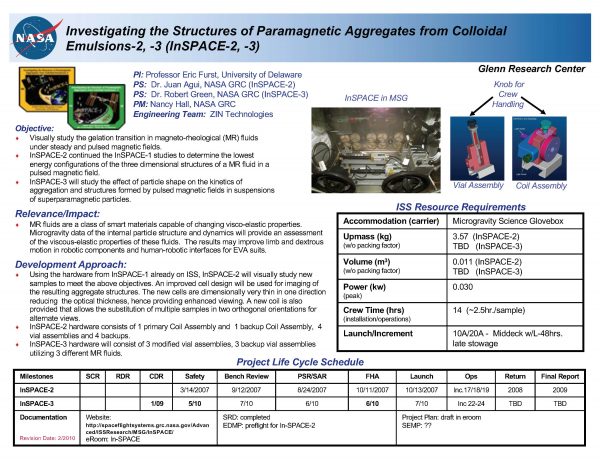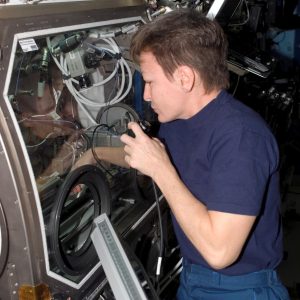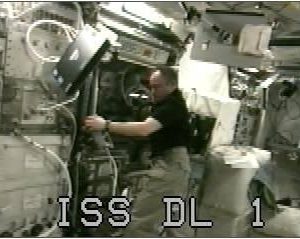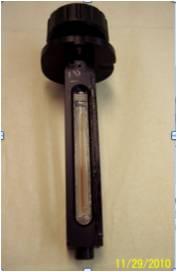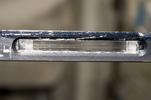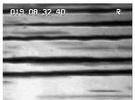InSPACE-3
Investigating the Structure of Paramagnetic Aggregates from Colloidal Emulsions-3
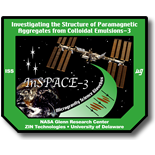
The use of external fields to control the microstructure of colloidal suspensions has long been recognized as a powerful means for tailoring the mechanical, optical and electronic properties of materials.
Magnetorheological (MR) suspensions, in particular, provide a striking example. These normally stable fluids undergo a dynamic transition to a solid within milliseconds after the application of an external magnetic field. They are also important models for developing methods of bottom-up fabrication of micro- and nano-structured materials and devices using field-directed self-assembly.
Investigating the Structure of Paramagnetic Aggregates from Colloidal Emulsions-2 (InSPACE-2) experiments focused on the structure of magnetically-polarizable particle suspensions over long times in steady direct current and pulsed magnetic fields. In pulsed fields especially, the long-time kinetics of the suspension micro-structural coarsening provided new and important results.
The InSPACE-2 experiments were the first to yield information on the full, three-dimensional aggregation process over timescales much longer than those accessible on the ground, which are limited by catastrophic sedimentation. Furthermore, the experiments identified a novel dynamic instability in which the suspension microstructures were observed to buckle at specific field frequencies and field strengths.
InSPACE-3 investigates the effect of particle shape on the micro-structural evolution of MR suspensions. Recent ground-based experiments demonstrate a startling effect that particle shape has on the interactions of dipolar chains and the resulting suspension microstructure. Specifically, the suspensions of paramagnetic ellipsoid-shaped particles are investigated. In combination with the results of InSPACE-2, it is hypothesized that particle shape will dramatically alter the aggregation kinetics, microstructures and microscopic mechanics.
This potentially leads to the ability to engineer enhanced properties of these suspensions, including suppression of the lateral aggregation in magnetorheological fluid-based electromechanical devices or the ability to create new colloidal materials through field-directed self-assembly.
Science Objectives
InSPACE-3 studies magnetic colloidal mixtures under the influence of various magnetic fields. A magnetic colloidal fluid contains materials which solidify when a magnetic field is applied to it, thus changing the physical properties of the liquid as a whole. Conducting these experiments aboard the International Space Station allows scientists to examine the network and arrangement of the ‘frozen’ solid structures unaffected by the force of gravity which can deform them on Earth.
Experiment Operations
InSPACE-3 is conducted inside the MSG work volume. The fluid sample in the vial assembly must be uniformly mixed prior to test operations. Thirty-six tests are performed, two or three per day. The vial assemblies may be reused indefinitely after restoring an even distribution to the particles within the fluid.
Video downlink is monitored on the ground during testing and provided to the Principal Investigator as desired. Sample return of the vial assemblies is not required. Video imagery is stored on 72 Mini-DVCAM tapes and 36 Hi-8 tapes for later return to the ground for more complete analysis.
The crew installs the hardware into the MSG, and uniformly distributes the particles in the fluid of the first vial assembly prior to installation in the hardware. Two DVCAMs and one Hi-8 tape are loaded into the video recorders in the video drawer. The crew member next focuses each optical train onto the particles in the center of the vial.
A test run starts by setting the current per the test matrix and then setting the pulse frequency of the current. Both are simple adjustments of dial pots by the crew while observing digital displays of the values of each. The current level controls the strength of the magnetic field applied to the MR fluid. A field of view (FOV) sweep and a focus sweep are performed right away with each optical train and then again about 20 minutes later.
The experiment runs autonomously with ground monitoring for the next two to three hours. Another FOV sweep and focus sweep for each optical train is performed prior to removing the magnetic field from the vial by setting the current to zero. Another run may be started with the same vial assembly after remixing the particles in the fluid, or a different vial assembly may be used. Upon completion of all testing, the hardware is removed from the MSG.
Applications
Space Applications
The quick phase-shifting property of magnetic colloidal fluids makes them potentially useful for devices such as optical interfaces and active noise and vibration dampers inside spacecraft. Future uses could include robotics, energy-transfer devices such as clutches, and other control systems.
Earth Applications
The work has application to directed self-assembly of crystalline structures from particles that may eventually allow creation of new nano-materials fabricated from nanoparticle building blocks, with potential applications in medicine, energy storage, chemical separations, and catalysis.
Magnetic colloidal fluid technology is currently used for shock absorbers in race cars and sport cars. This technology is expanding to include making large-scale building foundation stabilizers for areas prone to earthquakes.
Previous Missions
InSPACE, the precursor to InSPACE-2 was performed on ISS Expeditions 6, 7, 12 and 13.
Related Documents
Currently updating…
Publications
Journal Papers
- Biswal, S.L. and Gast, A. P. “Micromixing with linked chains of paramagnetic particles” Analytical Chemistry, 76 (21), 6448-6455, (2004).
- Biswal, S.L. and Gast, A. P. “Rotational dynamics of semiflexible paramagnetic particle chains” Physical Review E, 69 (4), Art No. 041406, Part 1 Apr 2004.
- Lyles, B.F., Terrot, M.S., Hammond, P.T. and Gast, A. P. “Directed patterned adsorption of magnetic beads on polyelectrolyte multilayers on glass” Langmuir, 20 (8), 3028-3031 (2004).
- Biswal, S.L. and Gast, A. P. “Mechanics of semiflexible chains formed bypoly(ethylene glycol)-linked paramagnetc particles” Physical Review E, 68 (2), Art No. 021402, Part 1 Aug 2003.
- Furst, E.M. and Gast, A. P. “Dynamics and lateral interactions of dipolar chains” Physical Review E, 62 (5), 6916-6925 (2000).
- Furst, E.M. and Gast, A. P. “Micromechanics of magnetorheological suspensions ” Physical Review E, 61 (6), 6732-6739 (2000).
- Furst, E. M., and Gast, A. P. “Micromechanics of dipolar chains using optical tweezers” Physical Review Letters, 82 (20), 4130-4133 (1999).
- Furst, E. M., and Gast, A. P. “Particle dynamics in magnetorheological suspensions using diffusing wave spectroscopy,” Physical Review E, 58, 3372 (1998).
- Furst, E. M., Suzuki, C., Fermigier, M., and Gast, A. P.”Permanently-linked monodisperse paramagnetic chains” Langmuir, 14 (26), 7334 -7336 (1998).
- Promislow, J.H.E.; and Gast, A.P., ”Magnetorheological Fluid Structure in a Pulsed Magnetic Field. Langmuir,”, vol. 12, no. 17, 1996, pp. 4095-4102.
- Promislow J.H.E and.Gast, A.P, “Low-Energy Suspension Structure of a Magnetorheological Fluid,” Phys.Rev. E 56 (1997) 642:651.
- Promislow, J.H.E, Gast, A.P. and Fermigier, M., “Aggregation Kinetics of Paramagnetic Colloidal Particles.” J.Chem. Phys. 102 (1995) 5492:5498.
Conference Presentations
- P.A. Vasquez, J. Agui, and E. M. Furst “Structural Transitions of MR Fluids in Microgravity,” Poster presentation, 79th Society of Rheology meeting, October 7-11, 2007, Salt Lake City, UT.
- A. Gast, B. Lyles, K. Bentley, J. Agui, and D. Pettit. “Magnetic Emulsions in Space”. Symposium in Honor of Darsh Wasan I: Interfacial and Colloidal Phenomena. AIChE annual meeting, November 16-21, 2003, San Francisco, CA.
Gallery
Contact Information
Principal Investigator: Professor Eric Furst, University of Delaware
Project Scientist: Dr. Robert Green, NASA GRC (InSPACE-3)
Project Manager: Nancy Hall, NASA GRC
Engineering team: ZIN Technologies

